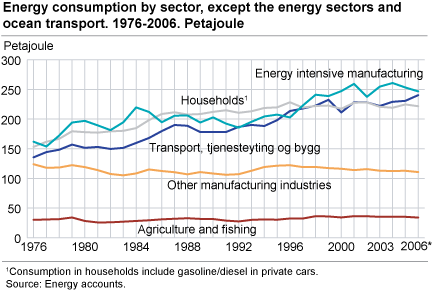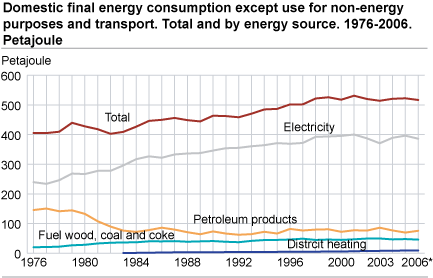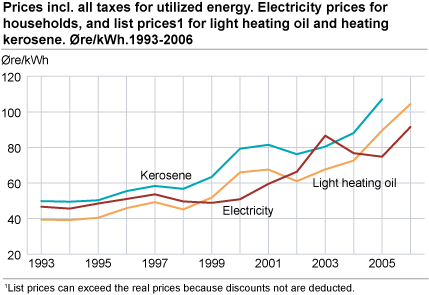Content
Published:
This is an archived release.
Growth in transport energy consumption
In spite of a high growth in energy used in transport, the total Norwegian consumption of energy was approximately the same in 2006 as in 2005. This is due to record electricity prices and lower activity in manufacturing industries.
While the energy consumption for transport purposes rose by about 5 per cent from 2005 to 2006, the energy consumption in manufacturing industries and other sectors fell by 3 and 0.6 per cent respectively. Total domestic consumption of energy (see explanation in text box) was almost unchanged from 2005, but the use of fossil fuels such as oil and gas rose, while the electricity consumption fell. The electricity consumption in Norway is to a large extent based on hydro power, except from imported electricity, which can also be based on coal, nuclear power etc.
Less precipitation and inflow to the water reservoirs in 2006 than in 2005 contributed to a drop in the electricity production of about 12 per cent, and thereby higher electricity imports. The temperature in 2006 was 1.8 degrees centigrade above the climatic average in the period 1961-1990 and 1.5 degrees centigrade above the average in 2005. The difference in temperature was partly due to a warmer summer in 2006, and therefore had limited effects on changes in energy consumption for heating purposes.
Lower energy consumption in manufacturing industries
The reduction in energy use in manufacturing was due to the shutdown or closing down of several enterprises within energy intensive industries and manufacturing of paper and paper products in 2006. These industries account for three quarters of the total energy consumption in manufacturing industries. The drop in energy use was especially significant within the manufacture of iron, steel and ferro-allays, down 12 per cent from 2005. This development is related to a considerable increase in energy prises and lower profitability since energy makes up a large part of the costs in many enterprises. Many energy intensive industries lost their cheap power contracts at the same time as the market prices on electricity reached a peak in 2006.
Oil products and gas also became more expensive in 2006. Still, the oil and gas consumption in manufacturing industries rose by 5 and 19 per cent from the previous year. Electricity is the most important energy source within manufacturing, and the increased use of other energy products did not compensate for the drop in electricity consumption, which declined by about 5 per cent from 2005.
More energy to transport purposes
The energy consumption for transport purposes reached 60 TWh in 2006, and has never been higher. This may be a result of increased travel in everyday life, on holiday or in relation to work. The transport growth can be regarded as a consequence of the general development in wealth. The purchasing power is good, and the commodities we buy must be transported. Consumption for transport purposes makes up a constantly higher chare of our energy consumption. In 2006, this accounted for 27 per cent of the energy consumption, against 23 per cent in 1990.
About two thirds of the energy consumption used for transport purposes (without foreign shipping) goes to road transport. Auto diesel and gasoline used in road transport rose by 3 per cent from 2005 to 2006, despite a gradual reduction in the average consumption per car as new cars are more energy-efficient. The energy consumption in air and costal transport rose by 101 and 8 per cent respectively.
Levelling out of residential energy consumption
Energy consumption in dwellings accounted for 20 per cent of total energy consumption in 2006, against 21 per cent in 1990. From 2005 to 2006, this consumption dropped by about 2 per cent, and was on about the same level as in 1994.
About three quarters of household stationary energy consumption is electricity, and the decline can be related to record high electricity prices. Households paid 91.5 øre/kWh on average for electricity in 2006, and this is 16 øre/kWh more than in the previous year. However, higher electricity prices stimulate to energy-efficiency efforts, and have for instance contributed to more widespread use of heat pumps in recent years.
Electricity was to some extent replaced by other energy sources in 2006. The preliminary figures show that the electricity consumption in households fell by 1.6 per cent from 2005, while consumption of heating oil rose by about 10 per cent. The price of heating oil also rose in 2006, but less than the electricity price. Consumption of district heating rose by 18 per cent from the previous year. District heating is not very widespread in Norway, and does not make up more that 1 per cent of the households’ energy consumption.
Fuel wood is the second largest energy source in households after electricity, and consumption of fuel wood dropped somewhat from the previous year. This can be due to a higher share of efficient, clean burning stoves for solid fuels and more frequent use of heat pumps for heating purposes.
|
We define net domestic energy consumption as end consumption of energy, excluding foreign shipping and energy producing sectors (extraction of oil, gas, district heating plants, electricity plants etc.). End consumption of energy appears in row 13 in the energy balance. |
1Corrected 07.11.2007.
Tables:
- Table 1 Energy sources balance sheet for Norway. 2006
- Table 2 Energy balance sheet for Norway. 2006. Petajoule
- Table 3 Energy balance sheet for Norway. 2006. GWh
- Table 4 Energy accounts. Extraction, conversion and use of energy goods. 2006. Preliminary figures
- Table 5 Energy accounts. Use of energy goods outside the energy sectors, by industry. 2006. Preliminary figures
- Table 6 Energy accounts. Extraction, conversion and use of energy goods. 2006. Preliminary figures. PJ
- Table 7 Energy accounts. Extraction, conversion and use of energy goods. 2006. Preliminary figures. GWh
- Table 8 Energy sources balance sheet for Norway. 2005
- Table 9 Energy balance sheet for Norway. 2005. Petajoule
- Table 10 Energy balance sheet for Norway. 2005. GWh
- Table 11 Energy accounts. Extraction, conversion and use of energy goods. 2005
- Table 12 Energy accounts. Use of energy goods outside the energy sectors, by industry. 2005
- Table 13 Energy accounts. Extraction, conversion and use of energy goods. 2005. PJ
- Table 14 Energy accounts. Extraction, conversion and use of energy goods. 2005. GWh
- Table 15 Energy use in Norway 1990-2006, exclusive international maritime transport and commodities used as raw materials. Renewable and not renewable energy. TWh and per cent.
- Table 16 Net consumption of individual energy bearers. 1976-2006.
- Table 17 Energi balance sheet. 1995-2006. Petajoule.
- Table 18 Percentage share of energy consumption, by individual energy bearers. 1983-2006.
- Table 19 Energy consumption in households. 1990-2006.
- Table 20 Energy consumption in households. 1990-2006. GWh.
- Table 21 Average electricity prices and list prices of selected petroleum products. Excluding and including taxes. 1993-2006.
- Table 22 Calculated prices of utilized energy. 1978-2006. Fixed 1998-prices. øre/kWh. All taxes included
- Table 23 Total supply and use of energy 1997-2006. GWh
- Table 24 Supply and use of electricity 1997-2006. GWh
The statistics is now published as Production and consumption of energy, energy balance and energy account.
Additional information
The statistics are published in spring and autumn. The spring publication is preliminary and aggregated to a larger degree, and only includes figures for energy balance. In the autumn publication, tables are also presented for the energy accounts.
Contact
-
Statistics Norway's Information Centre
E-mail: informasjon@ssb.no
tel.: (+47) 21 09 46 42



